Mahasukha, Mahāsukha, Maha-sukha: 11 definitions
Introduction:
Mahasukha means something in Buddhism, Pali, Hinduism, Sanskrit. If you want to know the exact meaning, history, etymology or English translation of this term then check out the descriptions on this page. Add your comment or reference to a book if you want to contribute to this summary article.
Images (photo gallery)
In Hinduism
Purana and Itihasa (epic history)
Source: archive.org: Shiva Purana - English TranslationMahāsukha (महासुख) refers to “great happiness”, according to the Śivapurāṇa 2.3.18 (“Description of the perturbation caused by Kāma”).—Accordingly, as Śiva described Pārvatī: “[...] Whatever is graceful and sweet in the creation has been incorporated here. Indeed, all her limbs are exquisite in every respect. How blessed is this Pārvatī of mysteriously wonderful features. There is no other woman equal to her in beauty in the three worlds. She is a storehouse of the finest beauty. She has wondrous beautiful limbs. She is an enchantress of even sages. She increases great happiness [i.e., mahāsukha-vivardhinī]”.
Source: Cologne Digital Sanskrit Dictionaries: The Purana IndexMahāsukha (महासुख).—A Vānara chief.*
- * Brahmāṇḍa-purāṇa III. 7. 233.

The Purana (पुराण, purāṇas) refers to Sanskrit literature preserving ancient India’s vast cultural history, including historical legends, religious ceremonies, various arts and sciences. The eighteen mahapuranas total over 400,000 shlokas (metrical couplets) and date to at least several centuries BCE.
In Buddhism
Tibetan Buddhism (Vajrayana or tantric Buddhism)
Source: eScholarship: Buddhajñānāpāda's Vision of a Tantric Buddhist WorldMahāsukha (महासुख) refers to one of the Saptāṅga (“seven aṅgas of mahāmudrā”), according to Vāgīśvavarakīrti’s Saptāṅga and Tattvaratnāvaloka (and its auto-commentary).—(Cf. the seven yogas mentioned by Buddhajñānapāda in the Muktitilaka).—The same seven factors are addressed in Vāgīśvavarakīrti’s later Saptāṅga and his Tattvaratnāvaloka and its auto-commentary, where they are called the seven aṅgas of mahāmudrā, with reference to which see Isaacson (2010b, 271, 271n27) and, with a bit more detail, Isaacson and Sferra (2014, 271), where they are mentioned with reference to a citation from the Saptāṅga in Rāmapāla’s Sekanirdeśapañjikā.
Source: OSU Press: Cakrasamvara SamadhiMahāsukha (महासुख) refers to “great bliss”, according to the Saṃvaramaṇḍala of Abhayākaragupta’s Niṣpannayogāvalī, p. 45 and n. 145; (Cf. Cakrasaṃvaratantra, Gray, David B., 2007).—[For Cakrasaṃvara]—The kapāla, "skull bowl", symbolizes śūnyatā, and is filled with blood symbolizing the nectar (amṛita) of great bliss (mahāsukha).—[For Vajravārāhī and Vajrayoginī]—Holding the kapāla, "skull bowl", while also embracing her hero, symbolizes conferring mahāsukha, "great bliss".
Source: MDPI Books: The Ocean of HeroesMahāsukha (महासुख) refers to “great pleasure”, according to the 10th-century Ḍākārṇava-tantra: one of the last Tibetan Tantric scriptures belonging to the Buddhist Saṃvara tradition consisting of 51 chapters.—Accordingly: “[...] [By means of things of the nature of] the great pleasure (mahāsukha) and so on, divine, and described in detail (or disapproved) by all Buddhas, oblation of the nature of the triple world is [to be made], by means of all things [as much as] possible. Gaurī and the other [goddesses] reside in the six realms [of reincarnation] and are goddesses of the Form, Formless, and the other (viz., Desire) [Realms]. [These goddesses] make offerings to the whole circle naturally [inclusive] of all things. [...]”.

Tibetan Buddhism includes schools such as Nyingma, Kadampa, Kagyu and Gelug. Their primary canon of literature is divided in two broad categories: The Kangyur, which consists of Buddha’s words, and the Tengyur, which includes commentaries from various sources. Esotericism and tantra techniques (vajrayāna) are collected indepently.
Languages of India and abroad
Sanskrit dictionary
Source: DDSA: The practical Sanskrit-English dictionaryMahāsukha (महासुख).—
1) great pleasure.
2) copulation.
-khaḥ a Buddha.
Derivable forms: mahāsukham (महासुखम्).
Mahāsukha is a Sanskrit compound consisting of the terms mahā and sukha (सुख).
Source: Cologne Digital Sanskrit Dictionaries: Shabda-Sagara Sanskrit-English DictionaryMahāsukha (महासुख).—m.
(-khaḥ) A Baudd'ha or Jaina saint. n.
(-khaṃ) Copulation. E. mahā great, and sukha happiness, pleasure.
Source: Cologne Digital Sanskrit Dictionaries: Monier-Williams Sanskrit-English Dictionary1) Mahāsukha (महासुख):—[=mahā-sukha] [from mahā > mah] m. ‘having gr° joy’, a Buddha, [cf. Lexicographers, esp. such as amarasiṃha, halāyudha, hemacandra, etc.]
2) [v.s. ...] n. ‘gr° pleasure’, copulation, [cf. Lexicographers, esp. such as amarasiṃha, halāyudha, hemacandra, etc.]
Source: Cologne Digital Sanskrit Dictionaries: Yates Sanskrit-English DictionaryMahāsukha (महासुख):—[mahā-sukha] (khaḥ) 1. m. A Buddha or Jaina sage. n. Copulation.
[Sanskrit to German]
Sanskrit, also spelled संस्कृतम् (saṃskṛtam), is an ancient language of India commonly seen as the grandmother of the Indo-European language family (even English!). Closely allied with Prakrit and Pali, Sanskrit is more exhaustive in both grammar and terms and has the most extensive collection of literature in the world, greatly surpassing its sister-languages Greek and Latin.
See also (Relevant definitions)
Starts with: Mahasukhacakra, Mahasukhalina, Mahasukhavivardhin, Mahasukhavivardhini, Mahasukhavriddhi.
Full-text: Makacukam, Vajrayana, Ananda, Lina, Vajramritamahatantra, Kapala, Padapa, Saptanga, Guhyasamaja, Vajramritatantra, Vajramrita.
Relevant text
Search found 12 books and stories containing Mahasukha, Maha-sukha, Mahā-sukha, Mahāsukha; (plurals include: Mahasukhas, sukhas, Mahāsukhas). You can also click to the full overview containing English textual excerpts. Below are direct links for the most relevant articles:
The Great Chariot (by Longchenpa)
Part 3 - The final summary < [H. The explanation of the primordial liberation of appearance and mind]
Part 3 - Passing the pass into freedom from viewed and viewer < [F. Passing the pass]
D. The dedication of the merit of this extensive explanation < [Chapter IV - Karma, Cause, and Effect]
Brihad Bhagavatamrita (commentary) (by Śrī Śrīmad Bhaktivedānta Nārāyana Gosvāmī Mahārāja)
Verse 2.2.7 < [Chapter 2 - Jñāna (knowledge)]
Verse 2.3.96-97 < [Chapter 3 - Bhajana (loving service)]
Lord Hayagriva in Sanskrit Literature (by Anindita Adhikari)
Worship (with and without form of image) < [Chapter 6]
Bhajana-Rahasya (by Srila Bhaktivinoda Thakura Mahasaya)
Text 1 < [Chapter 8 - Aṣṭama-yāma-sādhana (Rātri-līlā–prema-bhajana sambhoga)]
Maha Prajnaparamita Sastra (by Gelongma Karma Migme Chödrön)
Act 7.2: Description of the Śuddhavāsika and Brahmaloka gods < [Chapter XIV - Emission of rays]
Lakulisha-Pashupata (Philosophy and Practice) (by Geetika Kaw Kher)
Sahajayana and the point of overlap < [Chapter 2 - Spread and Transition]
